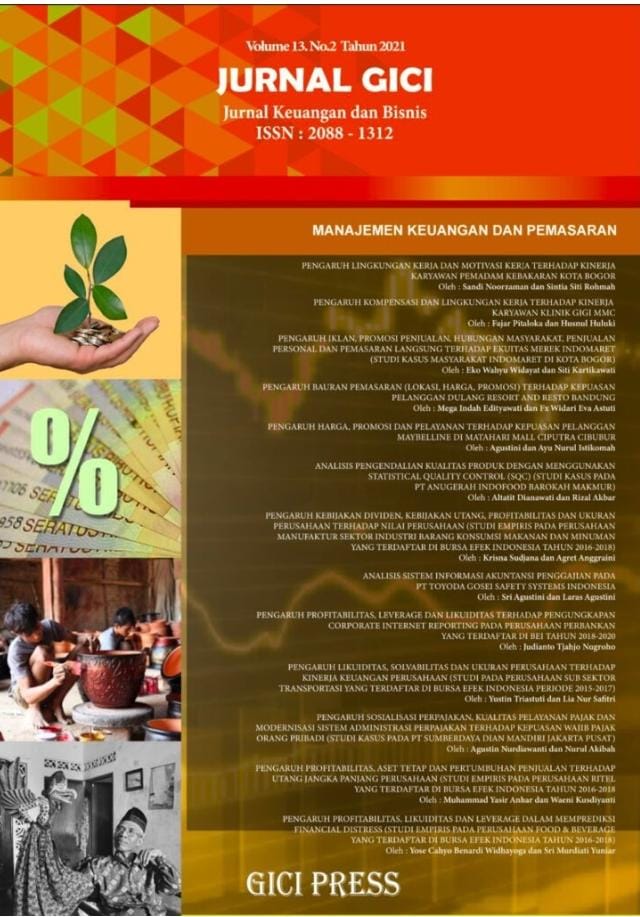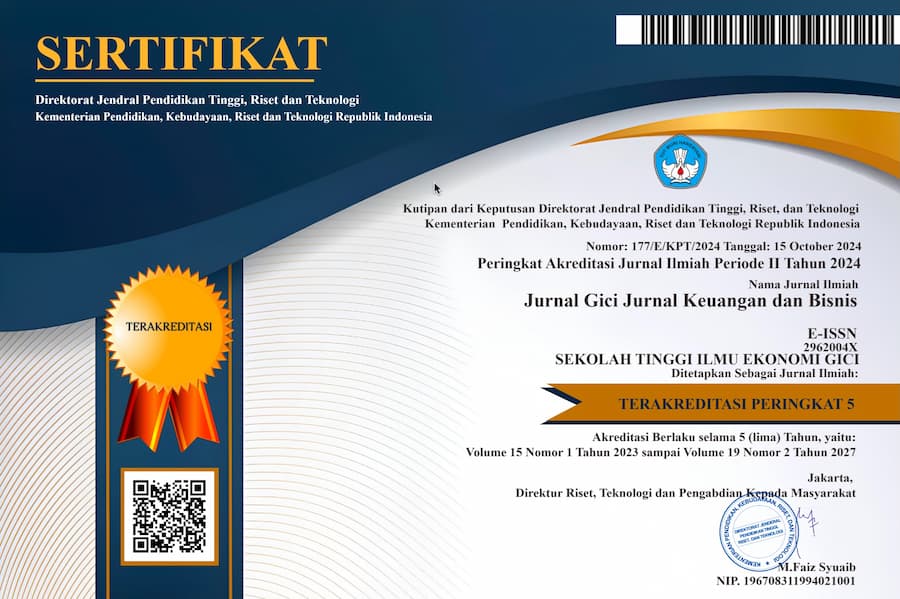PENGARUH LIKUIDITAS, SOLVABILITAS, DAN UKURAN PERUSAHAAN TERHADAP KINERJA KEUANGAN PERUSAHAAN (Studi pada Perusahaan Sub Sektor Transportasi Yang Terdaftar di Bursa Efek Indonesia Periode 2015-2017)
DOI:
https://doi.org/10.58890/jkb.v13i2.97Keywords:
Liquidity, Solvency, Company Size, Financial PerformanceAbstract
Indonesia's economic development in 2017 grew 5.07% higher than in 2016 which was only 5.03%. Especially growth in the transportation sub-sector experienced a growth of 8.49% on an annual basis. Economic development in the transportation sub-sector will certainly invite investors to invest, therefore information about a company's financial statements is needed. Information about the condition of the company's financial statements is very necessary to determine the company's financial performance. This study aims to examine the effect of liquidity, solvency and company size on the company's financial performance in transportation sub-sector companies for the period 2015-2017. The financial performance of the company is the dependent variable in this study, while the liquidity, solvency and size of the company are independent variables. The sampling method used is a sampling method with certain considerations (purposive sampling). The research method in this study is associative, while the analytical technique used in this study is multiple linear regression analysis. The results of the regression test show that 34.1% of the factors that affect the company's financial performance can be explained by the variables of liquidity, solvency and company size. The remaining 65.9% was explained by other factors not studied in the study. The existence of the F test shows that simultaneously the variables of liquidity, solvency and company size simultaneously have a significant effect on the company's financial performance. The results of the t test showed that liquidity and solvency variables did not have a significant effect on the company's financial performance with the calculated analysis values of (1.951) and (-0.602) respectively which were smaller than the table (2.01954). While the variable size of the company has a significant effect on the company's financial performance with a calculated analysis value (4,773) or greater than the table. Thus, the larger the size of the company, the company's financial performance will increase.Downloads
References
Dahlia, C. (2018). Pengaruh Struktur Modal, Ukuran Perusahaan, Solvabilitas terhadap Kinerja Keuangan. Jurnal Muara Ilmu Ekonomi dan Bisnis. ISSN : 2579-6224. Volume 2. No. 2. Oktober 2018. Program Magister Ekonomi. Universitas Tarumanegara. Jakarta.
Fahmi, I. (2013). Analisis Laporan Keuangan. Bandung: Alfabeta.
__________ (2011). Analisis Laporan Keuangan. Bandung: Alfabeta.
Ghozali, I. (2016). Aplikasi Analisis Multivariete dengan Program SPSS. Cetakan Kedelapan. Semarang: Badan Penerbit Universitas Diponegoro.
Hani, S. (2015). Teknis Analisis Laporan Keuangan. Medan: InMedia.
Harahap, S. S. (2009). Teori Kritis Laporan Keuangan. Jakarta: Bumi Aksara.
Ikatan Akuntan Indonesia. (2012). Pernyataan Standar Akuntansi Keuangan. Jakarta: Salemba Empat.
__________ (2015). Pernyataan Standar Akuntansi Keuangan. Jakarta: Salemba Empat.
Kasmir. (2018). Analisis Laporan Keuangan. Cetakan Kesebelas. Jakarta: Raja Grafindo Persada.
Khafa, L., Laksito, H. (2015). Pengaruh Ukuran Perusahaan, Leverage dan Keputusan Investasi terhadap Kinerja Keuangan. Jurnal Akuntansi. ISSN : 2337-3806. Volume 4. No. 4. Juli 2015. Program Studi Akuntansi. Universitas Diponegoro. Semarang.
Maulana R. (2018). Pertumbuhan Sektor Transportasi. http://ekonomi.bisnis.com. Web. 24 Februari 2019.
Munawir, S. (2010). Analisis Laporan Keuangan. Yogyakarta: Liberty.
__________ (2012). Analisis Laporan Keuangan. Yogyakarta: Liberty.
Republik Indonesia. (2008). Undang-Undang No.20 Tentang Usaha Mikro, Kecil dan Menengah.
Riyanto, B. (2011). Dasar-dasar Pembelanjaan Perusahaan. Yogyakarta: BPFE.
Rudianto. (2013). Akuntansi Manajemen Informasi untuk Pengambilan Keputusan Strategis. Jakarta:Erlangga.
Sawir, A. (2009). Analisis Kinerja Keuangan dan Perencanaan Keuangan. Jakarta: PT Gramedia Pustaka
Siagian, S.P. (2011). Manajemen Sumber Daya Manusia. Jakarta: Bumi Aksara
Sugiyono (2015). Metode Penelitian Kuantitatif, Kualitatif dan R&D. cetakan Kedua Puluh Dua. Bandung: Penerbit Alfabeta.
Sutrisno, E. (2009). Manajemen Keuangan Teori, Konsep dan Aplikasi. Yogyakarta:Ekonisia.
Utami, B.W., Pardanawati, L.S. (2016). Pengaruh Solvabilitas, Solvabilitas, dan Manajemen Aset terhadap Kinerja Keuangan. Jurnal Akuntansi dan Pajak. ISSN : 1412-6269X. Volume 17. No. 1. Juli 2016. Program Studi Akuntansi. STIE AAS. Surakarta.
Willy, Abdillah., J. Hartono. (2015). Partial Least Square. Yogyakarta: Andi.














